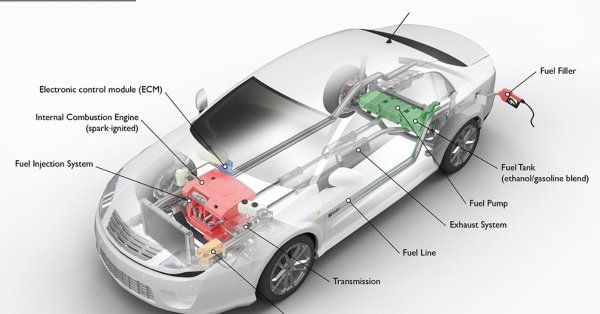Internal combustion engines are used in flexible fuel vehicles (FFVs), which may run on gasoline or any gasoline-ethanol mixture up to an ethanol content of 83%. FFVs have a single fuel system, and the majority of its parts are identical to those in a typical gasoline-only automobile. To account for the unique chemical characteristics and energy content of ethanol, certain ethanol-compatible components, such as adjustments to the fuel pump and fuel injection system, are necessary. Additionally, the engine control module (ECM) has been tuned to account for ethanol's greater oxygen concentration.
Key components of flexible fuel cars
Battery: The battery supplies electricity for the engine to start and for the electronics and accessories of the car.
Electronic control module (ECM): The ECM monitors vehicle operation, protects the engine from abuse, and discovers and resolves issues. It also regulates the fuel mixture, ignition timing, and emissions system.
Exhaust system: The exhaust system sends the engine's exhaust gases out the tailpipe. The exhaust system's triple way catalyst is intended to reduce engine-out emissions.
Gasoline filler: To fill the tank, a pump from a fuel dispenser is attached to the tank's receptacle on the car.
Fuel tank (ethanol/gasoline blend): This tank holds fuel inside the car so the engine can run.
Spark-ignited internal combustion engine: In this setup, fuel is pumped into the combustion chamber or the intake manifold, where it is mixed with air. A spark from a spark plug then ignites the air/fuel combination.
Transmission: The transmission converts electrical energy from the traction motor or engine into mechanical energy that powers the wheels.
